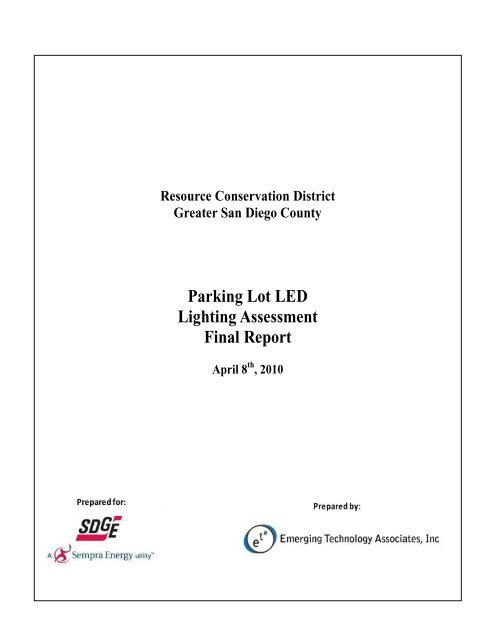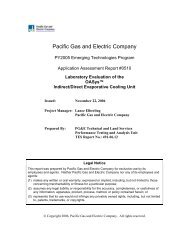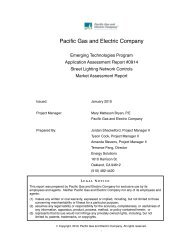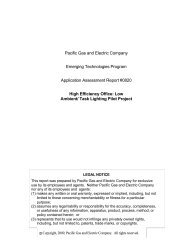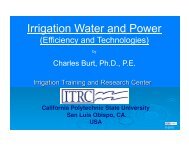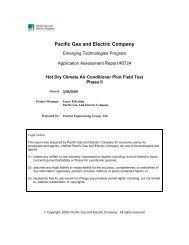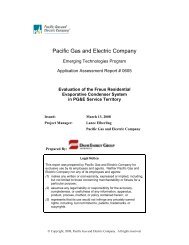Parking Lot LED Lighting Assessment Final Report - Emerging ...
Parking Lot LED Lighting Assessment Final Report - Emerging ...
Parking Lot LED Lighting Assessment Final Report - Emerging ...
Create successful ePaper yourself
Turn your PDF publications into a flip-book with our unique Google optimized e-Paper software.
Resource Conservation District<br />
Greater San Diego County<br />
<strong>Parking</strong> <strong>Lot</strong> <strong>LED</strong><br />
<strong>Lighting</strong> <strong>Assessment</strong><br />
<strong>Final</strong> <strong>Report</strong><br />
April 8 th , 2010
PREFACE<br />
PROJECT TEAM<br />
Page 1 of 15<br />
<strong>Parking</strong> <strong>Lot</strong> <strong>LED</strong> <strong>Lighting</strong> <strong>Assessment</strong><br />
This project is sponsored by San Diego Gas & Electric’s (SDG&E®) <strong>Emerging</strong> Technologies Program (ETP)<br />
with Jerine Ahmed as the project manager. Marty Leavitt, District Manager, was the contact and project<br />
manager for Resource Conservation District. Daryl DeJean (daryl.eta@gmail.com) from <strong>Emerging</strong><br />
Technologies Associates, Inc. provided technical consulting, data analysis, overall coordination of all<br />
parties involved, and finalized the report.<br />
DISCLAIMER<br />
This report was prepared as an account of work sponsored by San Diego Gas & Electric Company. While<br />
this document is believed to contain correct information, neither SDG&E®, <strong>Emerging</strong> Technologies<br />
Associates nor Resource Conservation District, nor any employees, associates, makes any warranty,<br />
expressed or implied, or assumes any legal responsibility for the accuracy, completeness, or usefulness of<br />
any information, apparatus, product, or process disclosed, or represents that its use would not infringe<br />
privately owned rights. References herein to any specific commercial product, process or service by its<br />
trade name, trademark, manufacturer, or otherwise, does not necessarily constitute or imply its<br />
endorsement, recommendation, or favoring by SDG&E®, <strong>Emerging</strong> Technologies Associates nor Resource<br />
Conservation District, their employees, associates, officers and members. The ideas, views, opinions or<br />
findings of authors expressed herein do not necessarily state or reflect those of SDG&E®, <strong>Emerging</strong><br />
Technologies Associates or Resource Conservation District. Such ideas, views, opinions or findings should<br />
not be construed as an endorsement to the exclusion of others that may be suitable. The contents, in<br />
whole or part, shall not be used for advertising or product endorsement purposes. Any reference to an<br />
external hyperlink does not constitute an endorsement. Although efforts have been made to provide<br />
complete and accurate information, the information should always be verified before it is used in any<br />
way.<br />
ACKNOW<strong>LED</strong>GEMENTS<br />
We would like to acknowledge Resource Conservation District and SDG&E® for their cooperation in the<br />
project. Without their participation, this assessment project would not have been possible.
TABLE OF CONTENTS<br />
Page 2 of 15<br />
<strong>Parking</strong> <strong>Lot</strong> <strong>LED</strong> <strong>Lighting</strong> <strong>Assessment</strong><br />
Executive Summary ..................................................................................................................................................... 5<br />
Introduction ................................................................................................................................................................ 6<br />
Project Background ..................................................................................................................................................... 7<br />
Project Overview ................................................................................................................................................. 7<br />
Technological Overview ...................................................................................................................................... 7<br />
Market Overview ................................................................................................................................................ 7<br />
Project Objectives ....................................................................................................................................................... 9<br />
Methodology ............................................................................................................................................................. 10<br />
Host Site Information ........................................................................................................................................ 10<br />
Measurement Plan ............................................................................................................................................ 10<br />
Equipment ......................................................................................................................................................... 10<br />
Electrical Demand and Energy Savings .............................................................................................................. 11<br />
<strong>Lighting</strong> Performance ........................................................................................................................................ 11<br />
Economic Performance ..................................................................................................................................... 11<br />
Conclusion ................................................................................................................................................................. 14<br />
Appendix A ................................................................................................................................................................ 15
Abbreviations and Acronyms<br />
CCT Correlated Color Temperature<br />
DOE Department of Energy<br />
ETP <strong>Emerging</strong> Technologies Program<br />
GWh Gigawatt Hour<br />
HID High Intensity Discharge<br />
HPS High Pressure Sodium<br />
IESNA Illuminating Engineering Society of North America<br />
kW Kilowatt<br />
kWh Kilowatt Hour<br />
<strong>LED</strong> Light Emitting Diode<br />
MH Metal Halide<br />
MWh Megawatt hour<br />
SDG&E San Diego Gas & Electric<br />
SSL Solid State <strong>Lighting</strong><br />
US United States<br />
W Watt<br />
Page 3 of 15<br />
<strong>Parking</strong> <strong>Lot</strong> <strong>LED</strong> <strong>Lighting</strong> <strong>Assessment</strong>
Page 4 of 15<br />
<strong>Parking</strong> <strong>Lot</strong> <strong>LED</strong> <strong>Lighting</strong> <strong>Assessment</strong><br />
List of Tables Page<br />
Table 1: Demand and Energy Savings .......................................................................................................................... 5<br />
Table 2: Simple Payback New Construction ................................................................................................................ 5<br />
Table 3: Demand and Energy Savings ........................................................................................................................ 11<br />
Table 4: Photopic Illuminance Results ....................................................................................................................... 11<br />
Table 5: Energy Cost Savings with <strong>LED</strong>s ..................................................................................................................... 12<br />
Table 6: New Construction Simple Payback Based Upon Energy Savings .................................................................. 12<br />
Table 7: New Construction Simple Payback Based Upon Energy and Annual Maintenance Savings with <strong>LED</strong>s ........ 12
EXECUTIVE SUMMARY<br />
Page 5 of 15<br />
<strong>Parking</strong> <strong>Lot</strong> <strong>LED</strong> <strong>Lighting</strong> <strong>Assessment</strong><br />
San Diego Gas &Electric (SDG&E®) was interested in evaluating <strong>LED</strong> technology in parking lot applications.<br />
Resource Conservation District agreed to participate in an assessment to determine the viability of an <strong>LED</strong> lighting<br />
solution for their parking lot. The goal of the project was to determine the energy savings potential provided by<br />
<strong>LED</strong> lighting as compared to the traditional high intensity discharge metal halide light source.<br />
Resource Conservation District was selected as an ideal site for the project due to the size of the parking lot. With<br />
only seven luminaires in the parking lot, the site allowed for a complete implementation of <strong>LED</strong> luminaires.<br />
Additionally, this was a new installation requiring the pole and luminaire, not just a retrofit of the luminaire.<br />
Quantitative light and electric power measurements were taken for the project. Electric energy and demand<br />
savings per <strong>LED</strong> luminaire are shown in Table 1. Based upon the annual operating cost savings and installed cost of<br />
an <strong>LED</strong> luminaire, the simple payback period for this new construction project is shown below in Table 2.<br />
<strong>Parking</strong> <strong>Lot</strong><br />
(4165 Operating hours)<br />
Table 1: Demand and Energy Savings<br />
# of Units Power (W) Demand (kW) Reduction (%) Energy (kWh) Reduction (%)<br />
250 W MH 7 291 2.0 - 8,484 -<br />
135 W <strong>LED</strong> 7 139 1.0 52 4,053 52<br />
<strong>Parking</strong> <strong>Lot</strong><br />
(4165 Operating hours)<br />
Table 2: Simple Payback New Construction<br />
# of Units<br />
Product Cost<br />
($)<br />
Incremental Cost<br />
($)<br />
Annual Energy<br />
Cost Savings ($)<br />
Simple Payback<br />
(years)<br />
250 W MH 7 8,196 - - -<br />
135 W <strong>LED</strong> 7 13,423 5,227 886 5.9<br />
This assessment project will assist numerous facility managers and building owners across the country when<br />
considering <strong>LED</strong> luminaires as an option for new lighting installations in parking lots meeting their energy efficiency<br />
as well as safety and security needs. Local site requirements, luminaire quality, as well as economic considerations<br />
may directly impact the outcome of similar assessment projects. Therefore, readers are advised that each<br />
installation is unique. It is recommended the reader exercise due diligence in selecting luminaires specific to<br />
their needs. The results of this project corroborate similar studies, specifically those conducted by Pacific Gas &<br />
Electric (www.etcc-ca.com).<br />
Based upon the findings of this project, and <strong>LED</strong> technologies potential, it is recommended that future projects<br />
consider the following:<br />
evaluating the benefits and acceptability of bi-level or adaptive lighting<br />
determination of the impact of <strong>LED</strong> lighting on security cameras and their ability to clearly<br />
depict images in the parking lot
INTRODUCTION<br />
Page 6 of 15<br />
<strong>Parking</strong> <strong>Lot</strong> <strong>LED</strong> <strong>Lighting</strong> <strong>Assessment</strong><br />
In response to an overwhelming interest in innovations in <strong>LED</strong> lighting technology for the outdoor area lighting<br />
applications, San Diego Gas & Electric’s <strong>Emerging</strong> Technologies Program conducted this assessment with the<br />
following objectives:<br />
identify potential <strong>LED</strong> solution for outdoor area lighting, specifically for parking lots<br />
assess <strong>LED</strong> lighting technologies, validating manufacturer’s claims regarding energy savings, light levels<br />
and light characteristics<br />
During early 2009, Resource Conservation District, located in Lakeside, California began considering options for<br />
their outdoor area lighting needs. The build out of their new office space allowed for the opportunity to include<br />
new parking lot lighting. In lieu of replacing dysfunctional poles and fixtures with traditional metal halide fixtures,<br />
<strong>LED</strong>s were the light source of choice. The construction was completed in July 2009.
PROJECT BACKGROUND<br />
Project Overview<br />
Page 7 of 15<br />
<strong>Parking</strong> <strong>Lot</strong> <strong>LED</strong> <strong>Lighting</strong> <strong>Assessment</strong><br />
The <strong>Parking</strong> <strong>Lot</strong> <strong>LED</strong> <strong>Lighting</strong> Technology <strong>Assessment</strong> project was conducted as part of the <strong>Emerging</strong> Technologies<br />
Program of San Diego Gas & Electric Company (SDG&E®). The <strong>Emerging</strong> Technologies Program “is an informationonly<br />
program that seeks to accelerate the introduction of innovative energy efficient technologies, applications<br />
and analytical tools that are not widely adopted in California. The information includes verified energy savings and<br />
demand reductions, market potential and market barriers, incremental cost, and the technology’s life expectancy.”<br />
<strong>Emerging</strong> Technologies Associates, Inc. was retained by SDG&E® to manage the <strong>Parking</strong> <strong>Lot</strong> <strong>LED</strong> <strong>Lighting</strong><br />
Technology <strong>Assessment</strong> project, develop project methodology, coordinate the participants and stakeholders and<br />
conduct the data collection and analysis for the project.<br />
The <strong>Parking</strong> <strong>Lot</strong> <strong>LED</strong> <strong>Lighting</strong> Technology <strong>Assessment</strong> project studied the applicability of light emitting diodes<br />
(<strong>LED</strong>s) in a parking lot application. At Resource Conservation District, the seven parking lot lights which were<br />
planned to be metal halide were replaced with an <strong>LED</strong> luminaire. The specification required a different pole and<br />
luminaire than originally planned. The applicability of the technology was determined by light output and power<br />
usage and economic factors.<br />
Technological Overview<br />
At the time of this assessment, <strong>LED</strong> lighting in outdoor area lighting applications such as parking lots was gaining<br />
momentum because of the light source’s ability to provide the required surface illuminance with improved<br />
uniformity and longer life using less energy than traditional light sources. The advancement of <strong>LED</strong> technology<br />
since the advent of white <strong>LED</strong>’s presents some significant opportunities in outdoor area lighting which includes<br />
parking lots. “<strong>LED</strong> technology is rapidly becoming competitive with high-intensity discharge (HID) light sources for<br />
outdoor area lighting” (source: www.netl.doe.gov/ssl DOE SSL <strong>LED</strong> Application Series: Outdoor Area <strong>Lighting</strong>).<br />
The most common light sources utilized to illuminate outdoor areas including streets, roadways, parking lots,<br />
parking structures and pedestrian areas are metal halide (MH) and high pressure sodium (HPS). The performance<br />
of these light sources is well documented with regard to lamp life and light characteristics. It is believed that a<br />
well-designed <strong>LED</strong> outdoor luminaire can provide at least comparable light characteristics as the traditional high<br />
intensity discharge light sources in an efficient manner (source: www.netl.doe.gov/ssl DOE SSL <strong>LED</strong> Application Series:<br />
Outdoor Area <strong>Lighting</strong>).<br />
The US Department of Energy (DOE) reports that <strong>LED</strong> technology is changing at a rapid pace. Overall, the<br />
performance of <strong>LED</strong> technology is quickly gaining efficiency but the cost remains a barrier to market entry.<br />
However, it should be noted that the costs for <strong>LED</strong> technology seems to be getting more competitive in the market<br />
place with each year that passes and technological advances are reaching outdoor area lighting applications.<br />
Market Overview<br />
The development of <strong>LED</strong>s for the outdoor area lighting niche represents a major breakthrough in energy efficiency<br />
advancement. This parking lot application normally (66%) involves high wattage high intensity discharge (HID)<br />
fixtures. The HID installed base of 3.1 million parking lot/garage/structure luminaires nationally. Currently, the<br />
market penetration of <strong>LED</strong>s in this sector is estimated at 0% because <strong>LED</strong> products for this application have only<br />
recently become available. Further market penetration is expected to increase, as lamp efficacy rises. 1<br />
1 Navigant Consulting, Inc. (2008). “Savings Estimates of Light Emitting Diodes in Niche <strong>Lighting</strong><br />
Applications.”
Page 8 of 15<br />
<strong>Parking</strong> <strong>Lot</strong> <strong>LED</strong> <strong>Lighting</strong> <strong>Assessment</strong><br />
Additionally, decreasing cost and increasing customer confidence in the quality and life expectancy will further<br />
reduce barriers to market adoption.<br />
California represents approximately 8.4% of the total energy consumption in the US. (source:<br />
http://tonto.eia.doe.gov/state/state_energy_profiles.cfm?sid=CA). Applying this 8.4% to the installed base of parking<br />
lot/garage lighting fixtures of 3.1 million units results in California having an estimated installed base of 260,400 of<br />
such fixtures. Assuming SDG&E® service territory equates to approximately 7% of California’s total installed base<br />
(based upon statistics located at http://www.ecdms.energy.ca.gov/elecbyplan.aspx data found in Appendix B), it is<br />
estimated that SDG&E® has an installed base of 18,228 parking lot/garage/structure fixtures in its service territory.<br />
100% market penetration would equate to approximately 130 GWh reduction in electricity use. Realistically,<br />
market penetration will most likely not ramp up until the high first cost barrier of <strong>LED</strong> luminaires is overcome.<br />
Assuming 0.5% market penetration each year would result in an electricity savings of approximately 650 MWh<br />
annually in SDG&E® service territory. This translates into 156.2 kW of reduced demand using 4165 annual<br />
operating hours (assumed to be equal to hours stated in street light LS-2 Rate) for outdoor area lighting in SDG&E®<br />
service territory.
PROJECT OBJECTIVES<br />
Page 9 of 15<br />
<strong>Parking</strong> <strong>Lot</strong> <strong>LED</strong> <strong>Lighting</strong> <strong>Assessment</strong><br />
The objectives of this project were to examine electrical, lighting, and economics of <strong>LED</strong> lighting technology in an<br />
outdoor area application, specifically a parking lot, as compared to the traditional light source of metal halide<br />
(MH). The potential electrical demand and energy savings were measured in terms of instantaneous system<br />
wattage. The parking lot operates 4165 hours annually (based upon SDG&E’s LS-2 Rate). <strong>Lighting</strong> performance was<br />
measured in terms of illuminance and Correlated Color Temperature (CCT) measured in Kelvin. <strong>Final</strong>ly, since this<br />
was a new installation the economic performance was calculated using the simple-payback for a new construction<br />
project.
METHODOLOGY<br />
Host Site Information<br />
Page 10 of 15<br />
<strong>Parking</strong> <strong>Lot</strong> <strong>LED</strong> <strong>Lighting</strong> <strong>Assessment</strong><br />
Resource Conservation District is a public service organization providing services throughout San Diego County.<br />
The location is the regional office providing office space for approximately 15 personnel.<br />
Resource Conservation District’s parking lot lighting was specified to be metal halide. The parking lot was to be lit<br />
by seven 250 W (nominal) metal halide (MH) fixtures. The parking lot is not a homogeneous area, meaning there is<br />
a small row of parking off the main entrance roadway, a small lot behind the front office building and another area<br />
near their warehouse building. The fixtures are mounted at a height of 18 - 24 feet with no real pattern of spacing<br />
between fixtures. The lights operate 4165 hours annually. The area does not have a surveillance camera. The<br />
customer’s blended electric cost is $0.20 per kWh.<br />
Measurement Plan<br />
A measurement plan was developed to measure the lighting performance of each luminaire. Pre installation<br />
lighting characteristics, power and energy is based upon manufacturer data for a 250 watt metal halide system. A<br />
data point grid was used to collect the illuminance for each light source. The Correlated Color Temperature was<br />
recorded at each data point as well. Instantaneous electrical power data for each luminaire was collected utilizing<br />
a Fluke meter.<br />
Equipment<br />
The following equipment was used to collect the light and power characteristic data.<br />
Illuminance and Correlated Color Temperature Meter: Power reading:<br />
Konica Minolta Chroma Meter, Model CL-500 Fluke 322 meter<br />
Accuracy: +- 2.0%<br />
http://www.konicaminolta.com/sensingusa/products/Light-Measurement http://www.fluke.com
PROJECT RESULTS AND DISCUSSION<br />
Electrical Demand and Energy Savings<br />
<strong>Parking</strong> <strong>Lot</strong> <strong>LED</strong> <strong>Lighting</strong> <strong>Assessment</strong><br />
The parking lot lighting consisted of seven 250 W metal halide (MH) fixtures. Based upon industry technical data,<br />
each MH fixture, consisting of the lamp and ballast, consumes 291 W. The new <strong>LED</strong> luminaire was stated as 135 W.<br />
This results in the <strong>LED</strong> luminaire using 52% less demand than the MH fixtures. Taking into account all seven<br />
fixtures in the parking lot, the annual reduction of energy usage is 18,396 kWh or 52% less as shown in Table 3.<br />
<strong>Parking</strong> <strong>Lot</strong><br />
(4165 Operating hours)<br />
Table 3: Demand and Energy Savings<br />
# of Units Power (W) Demand (kW) Reduction (%) Energy (kWh) Reduction (%)<br />
250 W MH 7 291 2.0 - 8,484 -<br />
135 W <strong>LED</strong> 7 139 1.0 52 4,053 52<br />
<strong>Lighting</strong> Performance<br />
For the assessment area, photopic illuminance and Correlated Color Temperature readings were taken. The focus<br />
of this section is on the parking area off the main entrance roadway. Photopic illuminance measurements were<br />
taken over a 175’ X 40’ area covering the one traffic lane and the parking stalls.<br />
Illuminance levels were measured on a 10’ X 10’ grid. The maximum and minimum illuminance levels were<br />
determined from all measurements. The ratio of these two values is known as the uniformity ratio. The<br />
Illuminating Engineering Society of North America recommends a minimum light level of one foot-candle and a<br />
maximum uniformity ratio for parking lot of 10:1. Table 4 contains the photopic illuminance data and uniformity<br />
ratios. It is evident that neither light source meets IESNA requirements in terms of maximum uniformity ratio or<br />
minimum light level. While the <strong>LED</strong> setup appears worse than the MH setup by IESNA numbers, in reality the <strong>LED</strong>lit<br />
parking lot “feels” a lot brighter than the MH setup, and appears perfectly fine in terms of light distribution and<br />
light quality. It was not in the scope of this study to determine from parking lot users or facility management<br />
whether they were satisfied with light levels and light quality.<br />
Luminaire<br />
Grid Points<br />
Illuminated<br />
(%)<br />
Table 4: Photopic Illuminance Results<br />
Average<br />
Illuminance<br />
(fc)<br />
Max<br />
Illuminance<br />
(fc)<br />
Min<br />
Illuminance<br />
(fc)<br />
Average-to-<br />
Minimum<br />
Uniformity<br />
Maximumto-<br />
Minimum<br />
Uniformity<br />
MH 100 1.08 5.04 0.05 22:1 101:1 3,860<br />
<strong>LED</strong> 100 5.52 21.15 0.13 31:1 163:1 6,280<br />
Economic Performance<br />
It is important to note that the cost and equipment assumptions made in this section apply only to Resource<br />
Conservation District. Resource Conservation District was assessing their selection of <strong>LED</strong> luminaires in lieu of<br />
high wattage high intensity discharge (HID) metal halide (MH) light sources. Therefore readers should consider<br />
their specific variables such as maintenance, energy, luminaire/lamp costs and type of light distribution before<br />
drawing any conclusions about the cost effectiveness of <strong>LED</strong> luminaires. For <strong>LED</strong> luminaires, luminaire/lamp<br />
lifetime is a function of all components of the luminaire (<strong>LED</strong>s, driver, housing, coatings, etc.), electrical and<br />
Page 11 of 15<br />
CCT
Page 12 of 15<br />
<strong>Parking</strong> <strong>Lot</strong> <strong>LED</strong> <strong>Lighting</strong> <strong>Assessment</strong><br />
thermal properties. Therefore, manufacturer claims, with regard to the aforementioned factors, are highly<br />
variable. Although the manufacturer data states 60,000 hours, the assumptions for <strong>LED</strong> life expectancy in this<br />
project is based upon 50,000 hours as per the United States Department of Energy website (source:<br />
http://apps1.eere.energy.gov/buildings/publications/pdfs/ssl/lifetime_white_leds.pdf).<br />
1. Energy Cost Estimates<br />
The energy cost is based upon the Resource Conservation District’s blended rate of $0.20 per kWh. Resource<br />
Conservation District’s parking lot lights operate 4165 hours annually. Table 5 provides the energy cost and savings<br />
estimate assuming all seven fixtures in the parking were converted from the base case metal halide to the new <strong>LED</strong><br />
luminaires.<br />
<strong>Parking</strong> <strong>Lot</strong><br />
(4165 Operating hours)<br />
Table 5: Energy Cost Savings with <strong>LED</strong>s<br />
# of Units Power (W) Energy (kWh)<br />
Annual Energy<br />
Cost ($)<br />
Annual Energy<br />
Cost Savings<br />
($)<br />
Reduction (%)<br />
250 W MH 7 291 8,484 1,697 - -<br />
135 W <strong>LED</strong> 7 139 4,053 811 886 52<br />
2. Payback Analysis<br />
The simple payback calculations for the new construction scenario considered the total investment cost and energy<br />
savings for the <strong>LED</strong>. In this project, the <strong>LED</strong> simple paybacks are shown in tables 7. Table 8 provides the<br />
maintenance savings derived based upon the costs provided by Resource Conservation District.<br />
<strong>Parking</strong> <strong>Lot</strong><br />
(4165 Operating hours)<br />
Table 6: New Construction Simple Payback Based Upon Energy Savings<br />
# of Units<br />
Product Cost<br />
($)<br />
Incremental Cost<br />
($)<br />
Annual Energy<br />
Cost Savings ($)<br />
Simple Payback<br />
(years)<br />
250 W MH 7 8,196 - - -<br />
135 W <strong>LED</strong> 7 13,423 5,227 886 5.9<br />
Table 7: New Construction Simple Payback Based Upon Energy and Annual Maintenance Savings with <strong>LED</strong>s<br />
<strong>Parking</strong> <strong>Lot</strong><br />
(4165 Operating hours)<br />
# of<br />
Units<br />
Incremental<br />
Cost ($)<br />
Annual<br />
Maintenance<br />
Cost ($)<br />
Annual<br />
Maintenance<br />
Cost Savings<br />
($)<br />
Annual<br />
Energy Cost<br />
Savings ($)<br />
Total<br />
Annual<br />
Savings<br />
($)<br />
250 W MH 7 - 8,484 1,697 - - -<br />
135 W <strong>LED</strong> 7 5,227 4,053 4,431 886 5,317 1.0<br />
The disposal fees were obtained from City of San Diego Environmental Services Department. To derive annual<br />
maintenance cost savings, the total maintenance cost was divided by the life expectancy of the light source.<br />
Payback<br />
(years)<br />
3. Luminaires and Lamp Life<br />
This report uses 50,000 hours as the <strong>LED</strong> life expectancy, per the DOE website (source:<br />
http://apps1.eere.energy.gov/buildings/publications/pdfs/ssl/lifetime_white_leds.pdf). The manufacturer of the<br />
<strong>LED</strong> luminaires assessed in this project claim life expectancies greater than 50,000 hours. James Brodrick, <strong>Lighting</strong>
Page 13 of 15<br />
<strong>Parking</strong> <strong>Lot</strong> <strong>LED</strong> <strong>Lighting</strong> <strong>Assessment</strong><br />
Program Manager, U.S. Department of Energy, Building Technologies Program, in a recent article entitled “Lifetime<br />
Concerns”, when discussing how best to define the longevity of <strong>LED</strong> luminaires stated: “That’s not a simple matter,<br />
because it doesn’t just involve the <strong>LED</strong> themselves, but rather encompasses the entire system-including the power<br />
supply or driver, the electrical components, various optical components and the fixture housing.”<br />
In this project, the <strong>LED</strong> life is approximately 12 years. This results in the payback being achieved at approximately<br />
one half of the <strong>LED</strong> life, making this scenario an attractive alternative. This is an optimistic statement due to the<br />
unproven life of <strong>LED</strong> products and does not indicate that <strong>LED</strong>s are necessarily a viable option for all similar<br />
situations.<br />
Actual performance data documenting the life of <strong>LED</strong> luminaires does not yet exist due to the relative infancy of<br />
<strong>LED</strong> technology for general illumination applications such as parking structure lighting. While <strong>LED</strong> technology<br />
appears to be a viable option for parking lot lighting, <strong>LED</strong> product quality can vary significantly among<br />
manufacturers. Therefore, it is recommended that readers exercise due diligence when selecting <strong>LED</strong> technology<br />
for any application. Readers should also be aware that <strong>LED</strong> life and lighting performance are dependent upon<br />
proper thermal and electrical design. Without the latter, premature failure may occur. Readers must properly<br />
assess the potential risk associated with <strong>LED</strong> technology which has not undergone proper testing (i.e. LM 79, LM<br />
80). The DOE <strong>LED</strong> Application Series: Outdoor Area <strong>Lighting</strong> Fact Sheet contains Design and Specifications<br />
Considerations: http://apps1.eere.energy.gov/buildings/publications/pdfs/ssl/outdoor_area_lighting.pdf<br />
4. Life Cycle Cost Analysis<br />
Even though life cycle cost analysis was not part of the scope of this project, a full life cycle cost analysis is<br />
recommended. There are many variables and considerations which are specific to each reader’s situation. It is<br />
recommended that variables such as labor, cost of materials, maintenance practices, cost of financing, inflation,<br />
energy rates, material cost, product life, etc. be determined for the specific project under evaluation.<br />
Due to the uncertainty as to future labor, product and other costs, especially for <strong>LED</strong> technology, readers are<br />
recommended to use their judgment and do their own due diligence regarding the future costs. Due to the rapid<br />
advancements in <strong>LED</strong> technology, the pricing of the products may be reduced. Readers are encouraged to obtain<br />
current price quotes for <strong>LED</strong> luminaires as the <strong>LED</strong> market is in a state of flux. Furthermore, each project’s<br />
economic analysis will yield its unique set of results depending upon the project sponsors and site requirements.
CONCLUSION<br />
Page 14 of 15<br />
<strong>Parking</strong> <strong>Lot</strong> <strong>LED</strong> <strong>Lighting</strong> <strong>Assessment</strong><br />
This assessment project demonstrated that properly designed <strong>LED</strong> luminaires can provide energy savings up to<br />
52% without compromising light characteristics required for parking lot applications.<br />
A lesson learned during this assessment project is that there are many factors that may be unique and require<br />
careful consideration. Each reader should consider their capital budgeting needs, maintenance and installation, as<br />
well as any internal lighting standards. While the results of this assessment indicate significant energy savings<br />
potential when <strong>LED</strong> luminaires replace high intensity discharge (HID) metal halide (MH) lighting, readers are<br />
encouraged to complete a life cycle cost analysis to gain the complete economic picture of a technological change<br />
out.<br />
While the results of this project attest to the leaps in technological enhancements of <strong>LED</strong> lighting technology, the<br />
high first cost required to retrofit outdoor lighting applications including parking lots with <strong>LED</strong>s will be the main<br />
barrier to significant market adoption. When using 50,000 hours as the expected life of the <strong>LED</strong> luminaire, the<br />
significant energy savings and reduced maintenance costs do not adequately offset this high initial first cost in a<br />
retrofit application. However, as illustrated by this project, <strong>LED</strong>s may be a viable option in a new construction<br />
application. Performance of <strong>LED</strong>s combined with growing market acceptance of their higher performance versus<br />
traditional outdoor area light sources may provide early adopters the impetus to invest in the emerging<br />
technology.<br />
Based upon the findings of this project, and <strong>LED</strong> technologies potential, it is recommended that future projects<br />
consider the following:<br />
evaluating the benefits and acceptability of bi-level or adaptive lighting<br />
determination of the impact of <strong>LED</strong> lighting on security cameras and their ability to clearly<br />
depict images in the parking lot
APPENDIX A<br />
SDG&E® Market Potential Calculations Reference<br />
California Electricity Statistics & Data<br />
http://www.ecdms.energy.ca.gov/elecbyplan.aspx<br />
Electricity Consumption by Planning Area<br />
Planning Area Description Year Total Usage<br />
Burbank, Glendale, and Pasadena 2007 4155.237028<br />
Dept. of Water Resources 2007 9956.406553<br />
Imperial Irrigation District 2007 3563.224165<br />
Los Angeles Department of Water 2007 25258.28371<br />
Other 2007 1709.525015<br />
Pacific Gas and Electric 2007 107987.2289<br />
Sacramento Municipal Utility District 2007 10917.07883<br />
San Diego Gas & Electric 2007 20492.55364<br />
Southern California Edison 2007 100470.2711<br />
Page 15 of 15<br />
<strong>Parking</strong> <strong>Lot</strong> <strong>LED</strong> <strong>Lighting</strong> <strong>Assessment</strong><br />
TOTAL 284509.8089<br />
SDG&E % 7.202758216


